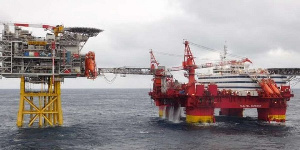Business News of Tuesday, 8 December 2020
Source: thebusiness24online.net
Coronavirus: Oilfield service purchases set to lose US$340 billion until 2028
 The oilfield service (OFS) market is projected to lose a cumulative US$340 billion in purchase value
The oilfield service (OFS) market is projected to lose a cumulative US$340 billion in purchase value
The oilfield service (OFS) market is projected to lose a cumulative US$340 billion in purchase value over the next eight years, a Rystad Energy analysis shows, as peak oil demand will arrive earlier and at a lower level than previously thought, leading to reduced E&P investments.
The COVID-19 pandemic’s effect and the accelerating energy transition last month impelled Rystad Energy to revise its peak oil demand forecast. We now see it coming in 2028, two years earlier than previously expected, at 102 million barrels per day, down from earlier projections of 106 million barrels per day.
OFS purchases are expected to drop to US$473 billion this year from US$625 billion in 2019 and remain flat in 2021 before starting a slow recovery.
Based on our updated peak oil demand forecast we now see OFS purchases returning to pre-pandemic levels only after 2024 in nominal terms, reaching US$642 billion in 2025. In real terms, excluding the impact of price inflation, annual purchases are not expected to revisit pre-pandemic levels this decade.
The US$340 billion of lost purchases value is spread across the coming eight years and is calculated as the cumulative difference between the current and the previous outlook for peak oil demand, which corresponds to a 6% drop.
We now expect investments to increase by 13% in 2022 (versus 17% previously) and 16% in 2023 (18% previously). Most of this downward revision is driven by shale investments, which previously were expected to grow by 45% in 2022 and now are pegged at about 30% growth.
Shale operators have been hit hard of late, and they also harborambitions to generate better cash flow by reducing their investment ratio. Growth in the offshore segment is revised down from 12% in 2022 to only 9%.
“With a lower need and willingness among E&P companies to invest in oil and gas, capital expenditure across offshore, shale and conventional onshore resources will probably struggle to get back to 2019 levels,” says Audun Martinsen, Head of Energy Service Research at Rystad Energy.
In nominal terms, offshore investment levels are projected to return to 2019 levels in 2023, with conventional onshore following suit in 2025 and shale in 2028. In real terms, however, investments in upstream oil and gas may never make it back to 2019 levels, Martinsen adds.










